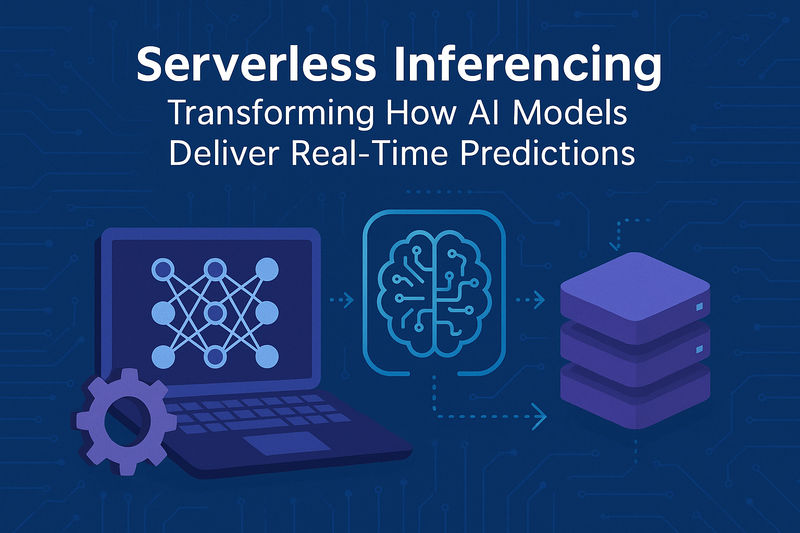In recent years, artificial intelligence (AI) and machine learning (ML) models have become pivotal to how businesses innovate, automate, and deliver personalized experiences. However, one major challenge has persisted: how to efficiently deploy these models for real-time use without the complexity and high costs of managing server infrastructure. The emergence of serverless inferencing addresses this challenge by redefining model deployment, scaling, and operations in a way that optimizes cost, speed, and agility.
What Is Serverless Inferencing?
Serverless inferencing is the process of running AI and ML models to generate predictions or inferences without requiring organizations to provision, manage, or maintain servers. Unlike traditional approaches where companies set up and scale dedicated server clusters for AI workloads, serverless inferencing entrusts underlying infrastructure management to cloud providers. Models are exposed via APIs that applications invoke on demand. The cloud platform automatically provisions compute resources, scales them dynamically based on request volume, then releases the resources when idle.
This means businesses pay only for the compute time consumed during inference execution, avoiding costs for idle servers or overprovisioning. The serverless model truly abstracts away infrastructure concerns, enabling developers to focus on building smarter applications and delivering AI capabilities faster.
How Serverless Inferencing Works
The typical workflow begins with uploading a pre-trained AI model (e.g., natural language processing or computer vision models) onto a serverless inferencing platform. Cloud providers like AWS, DigitalOcean, and specialized AI platforms offer seamless ways to deploy these models in containerized environments. Upon deployment, a serverless endpoint is created that listens for incoming inference requests.
When an application sends data to this endpoint through an API call (such as a user query or image), the platform automatically allocates the necessary compute resources for the model to process the input and generate a prediction. The platform scales resources up instantly if there is a spike in requests and scales down as traffic decreases—even to zero when inactive. This elastic nature eliminates the traditional burden of capacity planning and maintenance.
Key Benefits of Serverless Inferencing
No Infrastructure Management: Development teams no longer need to configure servers, manage clusters, or worry about patching and scaling. This dramatically reduces operational overhead and accelerates time-to-market for AI applications.
Cost Efficiency: Organizations pay strictly for the compute resources utilized during inference. For workloads with fluctuating or unpredictable traffic, this pay-per-use pricing yields significant savings compared to maintaining dedicated GPU or CPU instances that often remain underutilized.
Automatic Scaling: Traffic spikes are handled seamlessly without manual intervention, ensuring consistent application performance regardless of usage volume. Whether there are ten requests or millions, the model endpoint adapts in real time.
Rapid Deployment and Experimentation: Serverless setup enables developers to quickly publish and iterate on AI models, supporting agile workflows and innovation cycles by removing backend complexities.
Enhanced Reliability: Cloud providers typically offer high availability, fault tolerance, and automatic failover for serverless endpoints, improving application uptime while developers focus on core business logic.
Democratization of AI: By lowering the technical barriers associated with infrastructure, serverless inferencing empowers small and medium businesses to embed advanced AI features in their products without needing extensive IT resources.
Real-World Use Cases
Serverless inferencing is particularly valuable across scenarios where AI workloads are intermittent or scale unpredictably:
Conversational AI: Chatbots and virtual assistants can instantly scale to handle customer queries during peak hours without provisioning additional servers.
E-commerce Recommendations: Personalized product suggestions can be served on demand, scaling with user traffic fluctuations.
Real-time Data Processing: Applications that require on-the-fly image recognition, fraud detection, or sentiment analysis benefit from rapid inference responses without infrastructure delays.
Content Enhancement: Tools for grammar checking, tone adjustment, or style refinement in document editors benefit from seamless integration with serverless AI models.
Considerations and Trade-offs
While serverless inferencing provides significant operational ease and cost savings, there are trade-offs to consider. For example, fine-grained control over infrastructure, performance tuning, and cost optimization may be less flexible compared to self-managed deployments. Cold start latency, the delay when spinning up compute resources from zero, can impact response time-sensitive applications to some extent. However, cloud providers continuously improve mechanisms to minimize these latencies.
The Future of AI Deployment
Serverless inferencing represents a paradigm shift in how AI models are operationalized in production environments. It aligns perfectly with the broader cloud-native and event-driven computing trends, offering unmatched agility, scalability, and cost efficiency. As AI adoption continues to surge, serverless inferencing will be a fundamental building block empowering organizations to deliver powerful, real-time AI capabilities that drive business value while simplifying complexity.
In summary, serverless inferencing transforms the AI deployment landscape by removing infrastructure hurdles, enabling automatic scalability, and optimizing costs. It allows businesses to focus on innovation while delivering AI-powered experiences that are responsive, scalable, and economical. As cloud providers and AI platforms continue enhancing serverless capabilities, this approach will play an increasingly central role in making AI accessible and practical for all industries and scales of business.




Top comments (0)